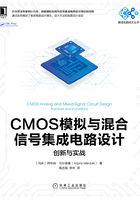
上QQ阅读APP看书,第一时间看更新
2.2 PN结
图2.1描述了电子从价带到导带的运动。

图2.1 一个电子移动到导带,在价带留下一个空穴
2.2.1 费米能级
图2.2显示了本征硅、P型硅、N型硅和PN结二极管的费米能级。

图2.2 各种结构的费米能级
2.2.2 耗尽层电容
PN结的形成导致在PN界面处形成耗尽层。耗尽层是指可动空穴或电子耗尽的区域。如图2.3所示,空穴穿过PN结,到达右边。

图2.3 PN结耗尽层形成
图2.4显示了一个N阱/P衬底二极管。图2.5显示了二极管反向时的总二极管耗尽电容。

图2.4 结的底部和两侧的PN结

图2.5 二极管耗尽电容与二极管反向电压的关系
2.2.3 存储电容
图2.6描述了正向偏置二极管中的电荷分布。二极管反向恢复测试电路如图2.7所示。

图2.6 正向偏置二极管中的电荷分布

图2.7 二极管反向恢复测试电路